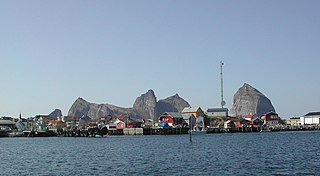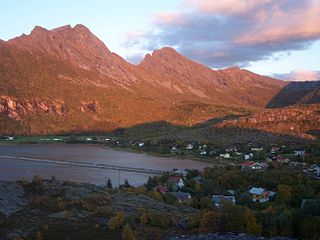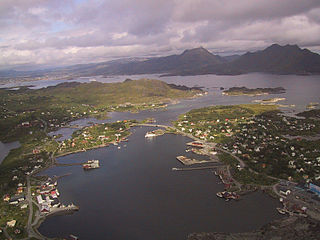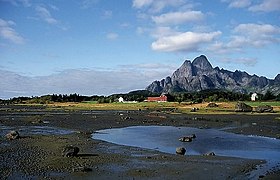
Brønnøy is a municipality in Nordland county, Norway. It is part of the Helgeland region. The administrative centre and commercial centre of the municipality is the town of Brønnøysund. A secondary centre is the village of Hommelstø. Other villages include Tosbotnet, Lande, Trælnes, and Skomo.

Vevelstad is a municipality in Nordland county, Norway. It is part of the Helgeland traditional region. The administrative centre of the municipality is the village of Forvik. The municipality is relatively small and isolated, with no road connections to the rest of Norway. It is only accessible by ferry, despite much of the municipality being located on the mainland.

Herøy is a municipality in Nordland county, Norway. It is part of the Helgeland traditional region. The administrative centre of the municipality is the village of Silvalen. The island municipality is located about 15 kilometres (9.3 mi) west of the town of Sandnessjøen.

Leirfjord is a municipality in Nordland county, Norway. It is part of the Helgeland traditional region. The administrative centre of the municipality is the village of Leland. Other villages in Leirfjord include Bardal and Sundøya. The large Helgeland Bridge is partly located in the municipality, connecting it to Alstahaug Municipality and the town of Sandnessjøen.

Træna is a municipality in Nordland county, Norway. It is part of the Helgeland traditional region. The administrative centre of the municipality is the island/village of Husøya. Other population centres include Selvær and Sanna.

Gildeskål is a municipality in Nordland county, Norway. It is part of the Bodø Region and the traditional district of Salten. The administrative centre of the municipality is the village of Inndyr. Other villages include Forstranda, Lekanger, Mevik, Mårnes, Nygårdsjøen, Saura, Storvik, Sør-Arnøy, Sørfinnset, and Våg.

Beiarn is a municipality in Nordland county, Norway. It is part of the traditional district of Salten. Beiarn is also a part of the Bodø Region, a statistical metropolitan region. The administrative centre of the municipality is the village of Moldjord. Other villages in Beiarn are Høyforsmoen, Trones, and Tverrvika.

Steigen is a municipality in Nordland county, Norway. It is part of the traditional district of Salten. The administrative centre of the municipality is the village of Leinesfjorden. Other villages include Leirvikbogen, Leines, Nordfold, Nordskot, and Sørskot. Engeløy Airport, Grådussan is located in the northern part of the municipality. Måløy–Skarholmen Lighthouse is located in the Vestfjorden in the western part of the municipality. The only road access to the municipality is via the Steigen Tunnel.

Hamarøy (Norwegian) or Hábmer (Lule Sami) is a municipality in Nordland county, Norway. It is part of the traditional district of Salten. The administrative centre of the municipality is the village of Oppeid. Other villages include Drag, Hellmobotn, Innhavet, Karlsøy, Korsnes, Presteid, Skutvika, Tømmerneset, Tranøya, and Ulvsvåg.

Lødingen is a municipality in Nordland county in Norway. Lødingen is located on the southeastern corner of the island of Hinnøya, and is part of the traditional district of Ofoten. The administrative centre of the municipality is the village of Lødingen. Other villages in the municipality include Våge and Ytterstad. Lødingen has the nickname "Biketown" because it hosts several annual bicycle races, including "Lofoten Insomnia" and Vestbygd-rittet.

Tjeldsund (Norwegian) or Dielddanuorri (Northern Sami) is a municipality in Troms county, Norway. The southwestern part of the municipality is part of the traditional district of Ofoten and the rest of the municipality is part of Central Hålogaland. The administrative centre of the municipality is the village of Evenskjer. Other important villages include Boltåsen, Fjelldal, Grov, Myklebostad, Ramsund, Renså, Sandstrand, and Tovika. Norges Brannskole is situated in Fjelldal. Marinejegerkommandoen is based south of Ramsund.

Røst is a small island municipality in Nordland county, Norway. It is part of the traditional district of Lofoten. The administrative centre of the municipality is the village of Røstlandet on the island of Røstlandet.

Værøy is an island municipality in Nordland county, Norway. It is part of the traditional district of Lofoten. The administrative centre of the municipality is the village of Sørland on the main island of Værøya. The other village in Værøy is Nordland. Most of the residents live in the Sørland area surrounding the main harbor. The old Værøy Lighthouse sits at the end of that harbor.

Flakstad is a municipality in Nordland county, Norway. It is part of the traditional district of the island group Lofoten. The administrative centre of the municipality is the village of Ramberg. Other villages in the municipality include Fredvang, Napp, Nusfjord, Sund, and Vareid.

Vestvågøy is a municipality in Nordland county, Norway. It is part of the traditional district of Lofoten. The administrative centre of the municipality is the town of Leknes. Some of the villages in the municipality include Ballstad, Borg, Bøstad, Gravdal, Knutstad, Stamsund, Tangstad, and Valberg. With over 11,600 inhabitants, Vestvågøy is the most populous municipality in all of the Lofoten and Vesterålen regions in Nordland county.

Hadsel is a municipality in Nordland county, Norway. It is part of the traditional district of Vesterålen. The administrative centre of the municipality is the town of Stokmarknes. Some of the main villages in Hadsel include Fiskebøl, Jarstad, Grønning, Grytting, Hanøyvika, Hennes, Kaldjorda, Melbu, Sanden, and Sandnes.

Moskenes is a municipality in Nordland county, Norway. The municipality comprises the southern part of the island of Moskenesøya in the traditional district of Lofoten. The administrative centre of the municipality is the village of Reine. Other villages include Sørvågen, Hamnøya, and Å.

Svolvær, Suolvearra (Northern Sami), or Spålavuolle (Lule Sami) is a town and the administrative centre of Vågan Municipality in Nordland County, Norway. It is located on the island of Austvågøya in the Lofoten archipelago, along the Vestfjorden. The 2.36-square-kilometre (580-acre) town has a population (2023) of 4,736 and a population density of 2,007 inhabitants per square kilometre (5,200/sq mi).

Valberg is a former municipality in Nordland county, Norway. The 57-square-kilometre (22 sq mi) municipality existed from 1927 until 1963. The municipality covered the southeastern coast of the island of Vestvågøya in what is now Vestvågøy Municipality. The administrative centre was the village of Valberg where Valberg Church is located.

Gimsøy is a former municipality in Nordland county, Norway. The 186.5-square-kilometre (72.0 sq mi) municipality existed from 1856 until its dissolution in 1964. It was located in the northwestern part of what is now Vågan Municipality. The municipality consisted of the island of Gimsøya and the northwestern part of the larger neighboring island of Austvågøya. The municipality also included 407 other small islands as well as hundreds of little islets and skerries, all of which are located in the Lofoten archipelago. The administrative centre was located at the village of Gimsøysand, where the Gimsøy Church is located.

































